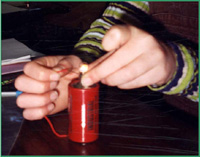Simple Circuits Curriculum

This lesson asks students to unpack their implicit causal models and to consider a Cyclic Simultaneous Model for explaining electrical flow at the particle level. It aims to help students move beyond Simple Linear or Cyclic Sequential Models. They discuss the models that they hold for how a simple circuit works in light of the supporting evidence. The Cyclic Simultaneous Model for energy flow is introduced and critiqued along with the other models.
Section 2: Understanding Goals
Subject Matter
- Electrons are conserved in a circuit.
- The bulb lights when electrons flow in the circuit. Flow requires a continuous "push."
- The battery does "work" by providing push or tension.
- Voltage can be thought of simply as push, or the force that moves electrons.
- The circuit is process-like, not substance-like. There is no point at which the circuit is "empty." Everything is made up of atoms; therefore, there are electrons all along the wire at all times.
Causality
- At the particle level, the causality in a Cyclic Simultaneous Model explains the process of flow better than Simple Linear or Cyclic Sequential Models. It involves thinking about the entire circuit as a system.
- In the Cyclic Simultaneous Model, electrons repel and are repelled by those around them. In essence, cause is effect and effect is cause. This results in flow.
- The battery completes the Cyclic Simultaneous Model by pushing the electrons back to the negative contact.
- It can be difficult to move beyond linear models of electrical flow. Many everyday experiences encourage us to view it as a linear process (such as one-way electrical cords coming out of appliances).


